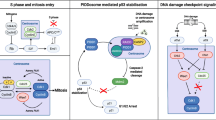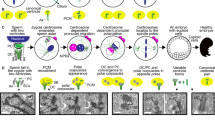Abstract
Centrobin/Nip2 was initially identified as a centrosome protein that is critical for centrosome duplication and spindle assembly. In the present study, we determined the expression and subcellular localization of centrobin in selected mouse tissues. Immunoblot analysis revealed that the centrobin-specific band of 100 kDa was detected in all tissues tested but most abundantly in the thymus, spleen and testis. In the testis, centrobin was localized at the centrosomes of spermatocytes and early round spermatids, but no specific signal was detected in late round spermatids and elongated spermatids. Our results also revealed that the centrosome duplication occurs at interphase of the second meiotic division of the mouse male germ cells. The centrobin protein was more abundant in the mitotically active ovarian follicular cells and thymic cortex cells than in non-proliferating corpus luteal cells and thymic medullary cells. The expression pattern of centrobin suggests that the biological functions of centrobin are related to cell proliferation. Consistent with the proposal, we observed reduction of the centrobin levels when NIH3T3 became quiescent in the serum-starved culture conditions. However, a residual amount of centrobin was also detected at the centrosomes of the resting cells, suggesting its role for maintaining integrity of the centrosome, especially of the daughter centriole in the cells.
Similar content being viewed by others
References
Andersen, J.S., Wilkinson, C.J., Mayor, T., Mortensen, P., Nigg, E.A., and Mann, M. (2003). Proteomic characterization of the human centrosome by protein correlation profiling. Nature 426, 570–574.
Bettencourt-Dias, M., and Carvalho-Santos, Z. (2008). Double life of centrioles: CP110 in the spotlight. Trends Cell Biol. 18, 8–11.
Blagden, S.P., and Glover, D.M. (2003). Polar expeditions-provisioning the centrosome for mitosis. Nat. Cell Biol. 5, 505–511.
Bornens, M. (2002). Centrosome composition and microtubule anchoring mechanisms. Curr. Opin. Cell Biol. 14, 25–34.
Jackman, M., Lindon, C., Nigg, E.A., and Pines, J. (2003). Active cyclin B1-Cdk1 first appears on centrosomes in prophase. Nat. Cell Biol. 5, 143–148.
Jeong, Y., Lee, J., Kim, K., Yoo, J.C., and Rhee, K. (2007). Characterization of NIP2/centrobin, a novel substrate of Nek2, and its potential role in microtubule stabilization. J. Cell Sci. 120, 2106–2016.
Krämer, A., Mailand, N., Lukas, C., Syljuåsen, R.G., Wilkinson, C.J., Nigg, E.A., Bartek, J., and Lukas, J. (2004). Centrosome-associated Chk1 prevents premature activation of cyclin-B-Cdk1 kinase. Nat. Cell Biol. 6, 884–891.
Krioutchkova, M.M., and Onishchenko, G.E. (1999). Structural and functional characteristics of the centrosome in gametogenesis and early embryogenesis of animals. Int. Rev. Cytol. 185, 107–156.
Loncarek, J., and Khodjakov, A. (2009). Ab ovo or novo? Mechanisms of centriole duplication. Mol. Cells 27, 135–142.
Manandhar, G., Schatten, H., and Sutovsky, P. (2005). Centrosome reduction during gametogenesis and its significance. Biol. Reprod. 72, 2–13.
Nigg, E.A. (2007). Centrosome duplication: of rules and licenses. Trends Cell Biol. 17, 215–221.
Piel, M., Meyer, P., Khodjakov, A., Rieder, C.L., and Bornens, M. (2000). The respective contributions of the mother and daughter centrioles to centrosome activity and behavior in vertebrate cells. J. Cell Biol. 149, 317–330.
Rhee, K., and Wolgemuth, D.J. (1997). The NIMA-related kinase 2, Nek2, is expressed in specific stages of the meiotic cell cycle and associates with meiotic chromosomes. Development 124, 2167–2177.
Saunders, P.T., Turner, J.M., Ruggiu, M., Taggart, M., Burgoyne, P.S., Elliott, D., and Cooke, H.J. (2003). Absence of mDazl produces a final block on germ cell development at meiosis. Reproduction 126, 589–597.
Tsou, M.F., and Stearns, T. (2006). Mechanism limiting centrosome duplication to once per cell cycle. Nature 442, 947–951.
Yamashita, S., and Okada, Y. (2005). Application of heat-induced antigen retrieval to aldehyde-fixed fresh frozen sections. J. Histochem. Cytochem. 53, 1421–1432.
Zou, C., Li, J., Bai, Y., Gunning, W.T., Wazer, D.E., Band, V., and Gao, Q. (2005). Centrobin: a novel daughter centriole-associated protein that is required for centriole duplication. J. Cell Biol. 171, 437–445.
Author information
Authors and Affiliations
Corresponding author
About this article
Cite this article
Lee, J., Kim, S., Jeong, Y. et al. Centrobin/Nip2 expression in vivo suggests its involvement in cell proliferation. Mol Cells 28, 31–36 (2009). https://doi.org/10.1007/s10059-009-0097-9
Received:
Revised:
Accepted:
Published:
Issue Date:
DOI: https://doi.org/10.1007/s10059-009-0097-9




